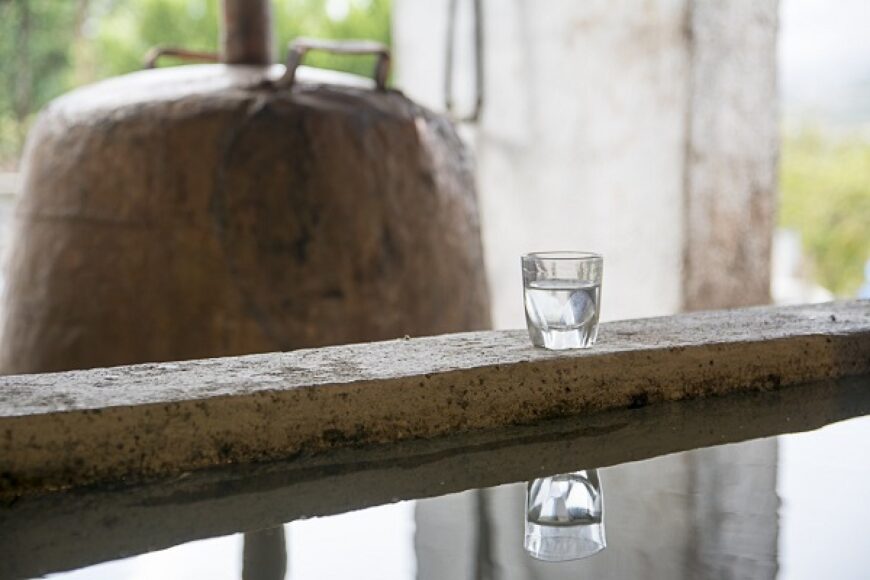“Wine to gladden the heart of man”, is what ancient Greeks believed, and following the example of God Dionysus, they drank wine and surrendered themselves to joy and merriment. As the years went by, modern Greeks evolved the process and since the Turkish occupation times they have been making wine from grapes, and after that, with the right process, they make a pure drink, which here in Crete we call Raki or Tsikoudia.
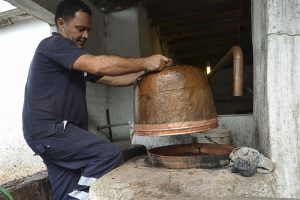
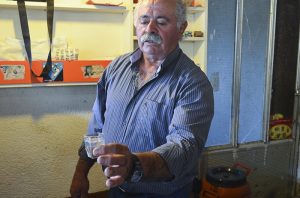
Our destination was a small village in the Agios Vasileios county, and specifically a cauldron that dates to the turn of the previous century! You will find the village of Agia Pelagia a short distance before Spili, while there have been reports of its existence since the Turkish Occupation era. It is a small village, with 40 residents, renowned for its many distillation cauldrons (pot stills). The entire village has 20 houses and 13 pot stills!!
Cretans like to express themselves through the traditional “mantinades” rhyming couplets, and they describe this custom with the following one: “For every two villagers there is one cauldron, with no coffee shop that’s how we pass our time”.
There, in the small village of Agia Pelagia we once more tasted and experienced the warm hospitality the villagers are renowned for, and especially the more elderly ones! Specifically, we visited the cauldron of the Polychronakis family! Mrs. Maria Tzobanaki, gladly agreed to speak to us about the method they use to make raki now, as well as how they made it 70 years ago when she was a young girl! Even though she is in her early 90s, she remembers the entire raki-making process , and recounted it for us.
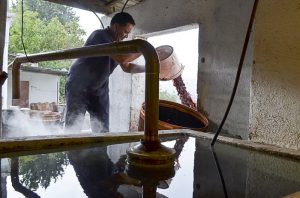
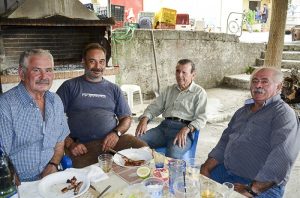
“The production of Raki in those years was a difficult process”, Maria told us. “We gathered the grapes and the donkey carried them in baskets to the vat. There we stomped on them, and after we crushed the grapes, we took out the grape must and left the grape marc inside the vat. We covered it with straw and rocks, and left it in there to ferment. After fermentation, about twenty days later, we transferred it to the cauldron to make the raki”, and she continues: “We didn’t have today’s cauldrons then. We had a big jar through which passed the funnel transferring the raki to the “kouroupi”, a big clay jar. All this was called a Mastelo. They rubbed the funnel with a cloth at the end of a stick, to cool off and help liquefy the vapours. The production of Raki was difficult! It took effort! Everything is easier now… they make raki without particular effort! But everything was more beautiful then, more pure … we made raki without a care in the world and without stress, problems or worries”.
Her husband, Mr. Tzobanakis, remembers the feasts and gatherings they had with the opportunity of the raki-making process. “All us villagers came together, family and friends, and we set up a feast thanks to the Raki”.
Another member of the group, Mrs. Aggeliki Polychronaki, a housewife for the past 60 years, shows us the dough which they still make today to seal the lid of the traditional cauldrons. “We now take barley flour, mix it with water and make the dough to seal the lid. We didn’t have enough flour in those days… we collected white dirt, made mud and used it to seal the lid”.
Mr. Stelios Aggelogiannakis takes his turn to describe the “Kouroupi”, explaining its use in the production of raki. “The Kouroupi was and still is the vessel that the Raki ends up in. Its mouth is narrow, to protect the Raki from evaporation, while it is barely wide enough to fit a man’s hand inside holding a small glass. After you fill the little glass with raki, you then close its top with your palm and tap it on your leg. The bubbles formed let you know how strong the Tsikoudia is. That is how we used to measure the strength of the Raki back then”.
Over time everything changes and evolves and what is left is the love of the people and their heart’s desire to have a good time. Just like in foregone centuries, in Agia Pelagia these days, as well as in all the villages in Crete, the production of tsikoudia and the opening of the cauldrons is an opportunity for gatherings of friends and feasts that last many days. Members of family, friends and loved ones are all invited to taste the warm Tsikoudia, and celebrate together with song and dance. Tsikoudia is a product that is never missing from any home in Crete. It accompanies the Cretans in all aspects of their life… in joys and sorrows, in family obligations and celebrations! That is why its production is considered not only important but also necessary!
Through the eyes of these people we got to experience and learn about their efforts to produce raki all those decades ago. Thanks to their warm smile combined with the heat of the cauldron, we felt very comfortable in their midst.
We tried the traditional kaltsounia that Mrs. Aggeliki made and tasted the warm delicacy from the cauldron’s fire… and while drinking warm raki we surrendered ourselves, like the followers of God Dionysus, to joy and fun… reciting:
“Oh, the wonderful raki, so potent,
I drink it and the floor turns into a ceiling”
Text: DIMITRIS MANOLITZAS
Photos: MARKOS DOULGERAKIS
MANOLIS HATZIDAKIS



